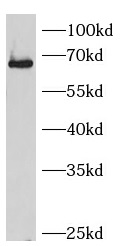产品
SMAD4 antibody
| 别称: | Mothers against decapentaplegic homolog 4 (MAD homolog 4 antibody, Mothers against DPP homolog 4)|Deletion target in pancreatic carcinoma 4|SMAD family member 4 (SMAD 4 antibody, Smad4 antibody, hSMAD4)|SMAD4|DPC4|MADH4 antibody | ||
| 货号: | FNab07995 | 反应性: | Human, Mouse |
| 宿主: | Rabbit | 验证实验: | ELISA, WB, IHC, IP |
| 克隆性: | polyclonal | 亚型: | IgG |
| 规格 | 价格 |
|---|---|
| 100μg | RMB ¥1900 |
| 50μg | RMB ¥1140 |
- 产品介绍
- 实验结果
- 实验条件
- 常见问题
- 产品名称
- SMAD4 antibody
- 货号
- FNab07995
- 规格
- 100μg
- 状态
- liquid
- 纯化方法
- Immunogen affinity purified
- 纯度
- ≥95% as determined by SDS-PAGE
- 克隆性
- polyclonal
- 亚型
- IgG
- 存储
- PBS with 0.02% sodium azide and 50% glycerol pH 7.3, -20℃ for 12 months(Avoid repeated freeze / thaw cycles.)
- 免疫原
- SMAD family member 4
- 别称
- Mothers against decapentaplegic homolog 4 (MAD homolog 4 antibody, Mothers against DPP homolog 4)|Deletion target in pancreatic carcinoma 4|SMAD family member 4 (SMAD 4 antibody, Smad4 antibody, hSMAD4)|SMAD4|DPC4|MADH4 antibody
- UniProt ID
- Q13485
- 分子量
- 60-70 kDa
- 验证实验
- ELISA, WB, IHC, IP
- 建议稀释比例
- WB: 1:500-1:2000; IP: 1:200-1:1000; IHC: 1:20-1:200
 HEK-293 cells were subjected to SDS PAGE followed by western blot with FNab07995(SMAD4 antibody) at dilution of 1:600
HEK-293 cells were subjected to SDS PAGE followed by western blot with FNab07995(SMAD4 antibody) at dilution of 1:600
 IP Result of anti-SMAD4 (IP:FNab07995, 4ug; Detection:FNab07995 1:600) with mouse liver tissue lysate 4000ug.
IP Result of anti-SMAD4 (IP:FNab07995, 4ug; Detection:FNab07995 1:600) with mouse liver tissue lysate 4000ug.
 Immunohistochemistry of paraffin-embedded human placenta tissue slide using FNab07995(SMAD4 Antibody) at dilution of 1:50
Immunohistochemistry of paraffin-embedded human placenta tissue slide using FNab07995(SMAD4 Antibody) at dilution of 1:50
- 背景介绍
- In muscle physiology, plays a central role in the balance between atrophy and hypertrophy. When recruited by MSTN, promotes atrophy response via phosphorylated SMAD2/4. MSTN decrease causes SMAD4 release and subsequent recruitment by the BMP pathway to promote hypertrophy via phosphorylated SMAD1/5/8. Acts synergistically with SMAD1 and YY1 in bone morphogenetic protein(BMP)-mediated cardiac-specific gene expression. Binds to SMAD binding elements(SBEs)(5'-GTCT/AGAC-3') within BMP response element(BMPRE) of cardiac activating regions(By similarity). Common SMAD(co-SMAD) is the coactivator and mediator of signal transduction by TGF-beta(transforming growth factor). Component of the heterotrimeric SMAD2/SMAD3-SMAD4 complex that forms in the nucleus and is required for the TGF-mediated signaling. Promotes binding of the SMAD2/SMAD4/FAST-1 complex to DNA and provides an activation function required for SMAD1 or SMAD2 to stimulate transcription. Component of the multimeric SMAD3/SMAD4/JUN/FOS complex which forms at the AP1 promoter site; required for synergistic transcriptional activity in response to TGF-beta. May act as a tumor suppressor. Positively regulates PDPK1 kinase activity by stimulating its dissociation from the 14-3-3 protein YWHAQ which acts as a negative regulator.
抗体可以回收利用几次?
一般抗体不推荐回收利用,抗体使用之后缓冲体系已经发生改变,不同客户在回收抗体的保存条件上也会有差异,所以抗体回收使用效果无法保证。
FineTest公司也做过一批抗体回收验证测试,测试结果显示不同抗体可回收次数不同,一般效价越高的抗体,可重复使用的次数越多,客户可根据实验情况来确定。
注:我们将孵育完毕后剩余的抗体回收到离心管中置于4℃保存,效价高的抗体可至少保存1周,重复利用3次左右。
FineTest公司抗体buffer成分是什么?
FineTest抗体成分一般是PBS含proclin300或sodium azide、BSA、50%甘油;也有一些是PBS含proclin300或sodium azide,50%甘油。防腐剂proclin300或sodium azide是常用的防腐剂,广泛应用于实验室和工业中。
FineTest公司抗体的保存温度和时间?
大部分抗体是放在-20℃保存,直标流式抗体需要放在2-8℃保存,质保期一年,质保期内抗体出现售后,可进行退货或换货。
一般抗体超过一年质保期仍旧可以使用,我们可以提供技术支持服务。
FineTest公司抗体使用需要稀释吗?用什么溶液稀释?
除了直标流式抗体为即用型,不用稀释。其他抗体一般为浓缩型,使用时需要按照说明书建议稀释比例稀释。
不同实验使用的稀释液不同,用PBST, TBST, 抗体封闭液等常用抗体稀释液均可。
免疫组化实验抗体的修复方式?
常用修复液:Tris-EDTA缓冲液(Tris-EDTA Buffer, pH 9.0);柠檬酸盐缓冲液(Citrate Buffer, pH 6.0)
热修复:
方法1:沸水浴修复,将盛有修复液和玻片的烧杯置于沸水浴环境,保持外部沸腾状态15min,自然冷却至室温;
方法2:微波修复,将盛有修复液和玻片的烧杯置于微波炉中,高火5min,停火3min,中火5min,自然冷却至室温。
如何选择二抗?
(1)二抗是和一抗反应的,所以二抗必须是抗一抗宿主物种,比如一抗来源于兔,对应二抗则选择抗兔二抗,比如羊抗兔或驴抗兔。
(2)根据实验类型选择二抗偶联物,比如做ELISA, 蛋白质印迹,IHC实验,常用酶联二抗,如HRP,AP等标记。而免疫荧光实验,流式细胞术实验中,则用荧光蛋白或染料标记,比如FITC,Cy3等。














